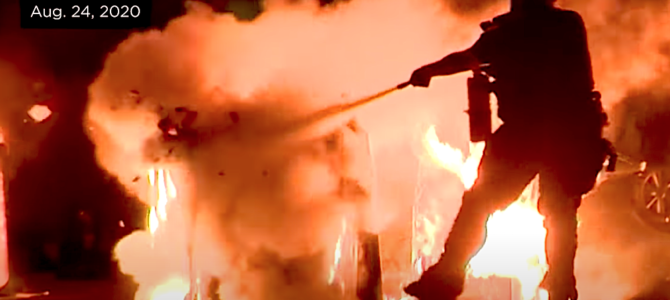
Clips of blazing businesses, the sounds of gunfire, and harrowing tales from Kenosha, Wisconsin, have inundated the social mediasphere and airwaves since violent riots broke out following the police shooting of 29-year-old Jacob Blake. The footage, it seems, is inescapable.
When one young man present at the riots Tuesday night fired his gun on three others, killing two and leaving the third injured, not only were on-the-ground reporters there to capture it in real-time, one of them rushed into the horrific scene to administer aid to one of the victims lying on the pavement, a gunshot wound in his head.
BREAKING someone has been shot. @RichieMcGinniss just carried him into a car. Directly across street from hospital
— Shelby Talcott (@ShelbyTalcott) August 26, 2020
This wasn’t a reporter from the Washington Post or CNN. In fact, on Monday night, when the violence began escalating and New York Times correspondent Julie Bosman figured she would be in for another long day Tuesday, she left for the night.
Bosman called the Kenosha County sheriff, who told her law enforcement was outnumbered. With only about 200 police officers and not enough National Guardsmen, he said 9-1-1 calls would pour in all night and officers are simply unable to respond timely enough. “So I realized that tomorrow was probably also going to be a long day,” Bosman said. “So I decided it was just time to get home.” Bosman didn’t respond to a request for an interview.
“As the night went on, it sure became less and less press,” noted Shelby Talcott, a media reporter at the Daily Caller who covered the Kenosha mayhem throughout the violent hours.
Julio Rosas, a senior writer at Townhall, told The Federalist that while the chaos and darkness made it difficult to tell which people amid the nightly riots were members of the press, “If they were there, they didn’t post any videos of it.” Journalists by nature love to be the first to break a story with original footage, meaning it’s highly unlikely that many mainstream reporters were on the streets recording but simply kept their videos to themselves.
Instead, in the absence of legacy media getting the full story in southern Wisconsin, online publications, freelancers, and live-streamers took to the streets to report.
Based on the work of the small group of reporters, including from the Daily Caller and Townhall, as well as freelancers such as Brendan Gutenschwager, all the puzzle pieces of the protests-turned-riots began to fit together, especially from Tuesday night, when the fatal shooting occurred. Talcott said it’s the Caller crew’s habit to spread out to cover as much ground as possible. As a result, we have eyewitness accounts and videos from multiple angles spanning the entire sequence of the night’s most notable events.
I interviewed the alleged shooter before the violence started.
Full video coming soon: pic.twitter.com/G3dVOJozN7
— Richie🎥McG🍿 (@RichieMcGinniss) August 26, 2020
Another angle of the shooting and moments after. Can see @RichieMcGinniss and others on scene giving aid. He was right next to the victim when the shooting happened.pic.twitter.com/CVfdc1DIQx
— Shelby Talcott (@ShelbyTalcott) August 26, 2020
(Warning, Graphic/Violent)
A crowd chases a suspected shooter down in Kenosha. He trips and falls, then turns with the gun and fires several times. Shots can be heard fired elsewhere as well, corroborating reports of multiple shooters tonight #Kenosha #KenoshaRiots pic.twitter.com/qqsYWmngFW— Brendan Gutenschwager (@BGOnTheScene) August 26, 2020
“Julio saw the second shooting, Richie saw the first shooting, I saw the guy being chased down the street,” Talcott noted. You can read her entire account of the night’s events here.
Mainstream Media Rely on Online Media
The New York Times later assembled a thorough and helpful timeline of events related to the shooting. But the truth is, the paper of record never could have done that work without the tenacity of online media reporters.
“Our team’s content is dominating the national news landscape right now because we were one of the few digital natives staffed with young and brave reporters who view it as their obligation to tell the American public what is really happening in our cities and neighborhoods,” Richie McGinniss, chief video editor at the Daily Caller who administered immediate aid to one of the shooting victims and rushed him to the hospital, told The Federalist in a statement.
If the last several months of deadly demonstrations around the country, following the deaths of George Floyd in police custody back in May and now Blake, have shown us anything, it’s that just because the mainstream reporters might go home when the sun goes down doesn’t mean violent rioters do.
WATCH: ‘WORST NIGHTMARE’: Indian immigrant’s family-run, Kenosha car dealership destroyed by BLM arsonists
“What we’ve seen with these riots and protests is that things become violent at night,” Rosas said, his words confirmed by countless videos of looting and arson despite the mainstream media continuing to insist protests have been “mostly peaceful.” “We can talk about peaceful protests,” Rosas continued, but “if you’re ignoring the riots just because you weren’t there, that’s a problem.”
“We’re out ’til 3:00, 4:00 in the morning, and those hours matter,” Talcott said. “I think it’s important to get all parts of the story. … The problem is that everybody reports when it’s peaceful, not so much when it’s violent,” she continued. “It’s part of the story. It’s going to be part of history. It’s both peaceful and non-peaceful. They’re not mutually exclusive.”
When mainstream outlets did finally report on the scene at night, they lied about what was going on around them.“Fiery But Mostly Peaceful Protests After Police Shooting,” one CNN chyron blared, as reporter Omar Jimenez stood in front of an inferno of cars early Tuesday morning.
“When you had CNN at Kenosha, they had a narrative. They were trying to say it was mostly peaceful … as a building was burning behind them,” Rosas said, pointing to MSNBC’s similar reporting in Minneapolis. They just got it “completely wrong,” he continued. “That’s why people don’t like the media, and I don’t blame them.”
"This mostly a protest. It is not, generally speaking, unruly.
But fires have been started."
MSNBC reporter says protests in Minneapolis are not "generally speaking, unruly" as buildings burn in the background. pic.twitter.com/IzzEmKgxhM
— Washington Examiner (@dcexaminer) May 29, 2020
Americans Need the Full Story
Even as most Americans believe the free press is essential to self-government, their confidence in the media has eroded sharply in recent years. According to a 2019-2020 Gallup/Knight Foundation study, 86 percent of Americans believe there’s at least a fair amount of political bias in news coverage, with 49 percent perceiving “a great deal” of bias. Republicans especially doubt what they see on television and read in the headlines.
Depending on their sources for news, Americans are consuming vastly different accounts of the events unfolding around the country, but if it weren’t for these teams of persistent online media reporters, it’s likely Americans wouldn’t even have access to the truth. Press conferences, rallies, and interviews with local business owners as they clean up broken glass in the daylight — these all make for nice stories, but they ignore unfortunate realities, and they demonstrate a lack of both journalistic curiosity and ultimately integrity. Americans need access to what unfolds when things turn a dark corner, long after mainstream reporters become frightened or tired.
“Our team’s goal in Kenosha was simple,” McGinniss told The Federalist. “[G]ather a complete picture of the events as they unfolded, interviewing citizens cleaning up the streets the day after, protesters with good intentions, those bent on destruction of property, and even the armed individuals who were guarding businesses in a show of force.” In other words, his team’s goal was to convey the whole story, peaceful and non-peaceful alike.
“If we didn’t tell [the story], would it get out?” Talcott asked. “Would anyone know what’s going on? I’m not sure.”









